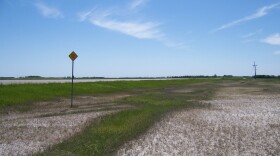Much of central and eastern North Dakota is pothole country. As you look out at all those sloughs, it appears that the vast majority of them are dominated by cattails. Those sloughs have been changing more than most people realize.
The common cattail is native to North Dakota as well as much of North America. It produces the large “cattails” (clusters of female flowers) that are comparable in size to a hotdog. The oldest specimen of the species in the NDSU herbarium was collected in 1891.
The narrowleaf cattail (Typha angustifolia) is probably a native to Europe with the first NDSU collection dating to 1942. It produces a cattail that is more comparable to a sharpie or large pencil. And as the name implies, it has narrower leaves than the common cattail.
There is also a hybrid of the two species. The earliest date for a collection of it in the NDSU herbarium is 1963. The hybrid is quite variable, with characteristics that are often in between those of the parent specie.
Just before World War I, there was an extensive survey of wetland vegetation in North Dakota, and they found few wetlands dominated by cattails. How things have changed!
The hybrid has been spreading rapidly in the region. Even though it may not reproduce sexually, once one of the hybrids becomes established, it can spread quickly by rhizomes and fragmentation. Hybrid cattail is more competitive than either of the parent species, and has become quite invasive. Most of the thick, dense, stands of cattails in the region are hybrid cattail.
Hybrid cattail flourishes where it receives nutrient and sediment from the adjacent uplands. The dense stand expands, eliminating other more desirable aquatic plants as well as animal life.
Although these dense and extensive stands of hybrid cattail may provide winter cover for pheasants and deer, they may actually be avoided by ducks, which need more interspersion of open water and vegetative cover.
—
Further Reading:





